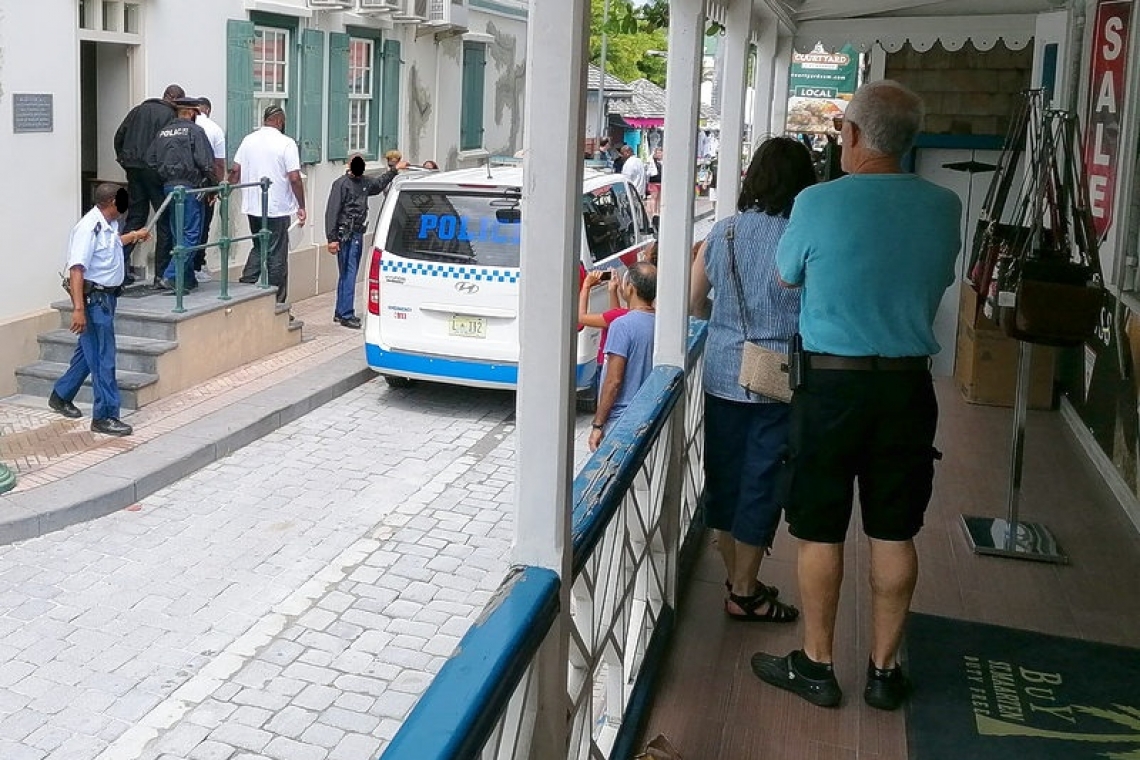Bystanders watch while Ottley and Richardson are escorted to a waiting police car on February 26. (file photo)
PHILIPSBURG--Dante Ottley (25) and Stevevanus Richardson (20) are soon to be released from prison after the Court of First Instance on Wednesday found they had acted in self-defence when they shot and killed a man and seriously injured another during an altercation outside adult entertainment club El Capitan in Sucker Garden on December 31, 2018.
However, the Court found them guilty of gun possession and sentenced them to 21 months in prison, six months of which are suspended, on three years’ probation. Given that Ottley and Richardson have been detained since January 2, 2019, they are to be released shortly.
The Prosecutor’s Office said on Wednesday afternoon that it will appeal the verdict.
As a result of the shooting, M.M. Gomez Lopez (28) died in the emergency room of St. Maarten Medical Center (SMMC). The other victim, W. James, who was wearing a bulletproof vest during the incident, sustained injuries to his legs and arm. Gomez, who was shot from behind, sustained six bullet wounds. James was shot no fewer than 10 times.
The prosecutor and the Sulvaran-Roseburg-Bommel defense team both showed surveillance-camera footage in the courtroom during the trial on February 26. These revealed that the men involved in the shooting had a number of “unfriendly” exchanges during the last night of 2018.
According to the prosecutor, Ottley and Richardson were the aggressors in this case, but according to the defendants and their lawyer, they had been threatened and harassed throughout the night, as Gomez apparently believed that Ottley had been involved in the death of his “homie”, who had been killed at another adult club two weeks earlier.
The Sulvaran-Roseburg-Bommel defense team went to great lengths to explain what had happened in and outside the club prior to the shooting and how his clients had been harassed, followed at every step and “repeatedly” threatened with their lives and told they would not be leaving the club’s parking lot alive. Knowing their assailants were armed and that one of them was wearing a bulletproof vest, both suspects said they had been confused and frightened by the allegations, which had given them no other choice but to shoot.
According to the prosecutor, Gomez was drunk and did not pose a threat to the suspects, who were agitated and angry.
In its verdict, the Court found it proven that Gomez had confronted Ottley both inside the club and in the club’s parking lot. It also found it proven that Gomez had issued death threats to Ottley, as evidenced by camera footage depicting Gomez making “shooting” hand gestures in Ottley’s and Richardson’s direction. The Court also said Gomez did not appear intimidated or frightened when the much-larger Ottley reacted emotionally to his words and gestures.
While the Court considered it proven that James was wearing a bulletproof vest, it said it could not be proven or disproven whether James and Gomez were armed. Video evidence and James’ statement showed that persons were not searched for weapons that night on entering the club.
James had also told authorities that Gomez had had a gun in his possession earlier that day. Before going to El Capitan, they made a stop at Gomez’ home and James assumed Gomez had left the gun there.
According to the Court, a gun was not found in Gomez’ home during a search conducted after the shooting and thus there are no indications that he left the gun at home.
“The images that record how Gomez was shot are vague, on which there are only shadows and no details that could give a definite answer. It is therefore plausible that the victim [Gomez – Ed.] still had a firearm at the time of the incident,” said the Court.
The Court also said the fact that Gomez was shot from behind does not immediately disqualify the shooting as an instance of self-defence.
“The images show that Gomez runs away from the suspects shortly before the suspects open fire. … It is conceivable that Gomez took out his weapon before turning towards the suspects and the suspects saw that. … It is therefore not certain that the suspects were the first to draw a weapon,” according to the Court.
The Court said Ottley and Richardson had been compelled to defend themselves against Gomez and James.
“At the time Gomez drew his weapon, the suspects stood between Gomez and the bulletproof vest-wearing James, and the suspects had no other meaningful alternative defence than to shoot at Gomez.
“Withdrawal was not possible. The suspects were followed on their way out by Gomez and James, and the suspects could not be expected to leave by car during those threats, given previous shooting incidents involving victims being found dead at the wheel of their cars.
“The immediate unlawful assault made it necessary for the suspects to continue to defend themselves by also shooting James, who was running away. It should be remembered that the shooting incident happened within seconds and that the emergency was only over when James was disarmed. The conclusion is that the appeal to self-defence is successful and that the proven firearm violence is not punishable,” concluded the Court in its verdict.
Relatives of Gomez had filed for damages to the tune of almost US $22,000. The Court declared these claims “inadmissible” in the criminal proceedings. However, the Court also said they can bring forward the claims in civil court.







